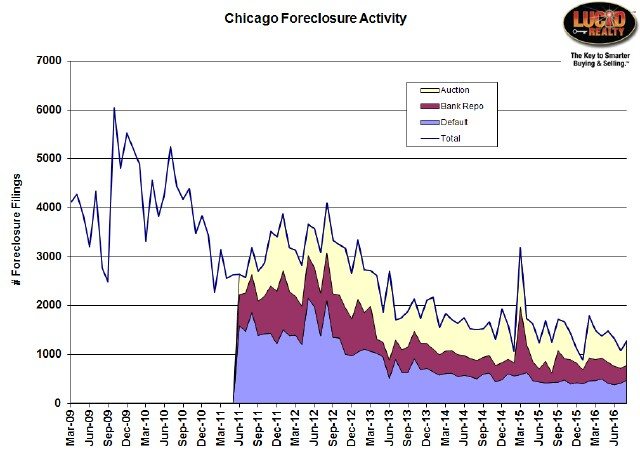I don’t think that RealtyTrac is going to come out with their usual monthly Foreclosure Market Report (for August) this month. They often have more interesting things to write about – especially since the foreclosure story has been rather boring for a while. Foreclosure activity has basically flattened out and doesn’t change that much from one month to the next.
Nevertheless, they do update their local market data so I can tell you how Chicago foreclosure activity was in August. As you can see in the graph below it increased from July but that was to be expected since July was pretty close to a record low. What was not expected was that for the first time in 16 months foreclosure activity was up from last year. This is only the 2nd time in 46 months that that has happened.
An increase in overall foreclosure activity, measured in the way RealtyTrac reports it, is not necessarily a bad thing. Moving foreclosures through the pipeline and getting them to the point where they go to auction and/ or the bank takes possession of them is not bad. It gets the problem behind us. What is bad is when defaults increase and they did in fact increase in August from July and from last year.
However, looking at the graph below you can see that this could all be well within the range of normal fluctuations.
Chicago Shadow Inventory
The net result of all this is that Chicago’s foreclosure pipeline has ticked up the last couple of months but if you look at the graph below you can see that has been essentially flat for the last year or so.
Although RealtyTrac didn’t issue their normal foreclosure market report they did issue their Q3 2016 U.S. Residential Property Vacancy and Zombie Foreclosure Report a few days ago. I’m a little confused as to how this can be a Q3 report when we are currently in the middle of the third quarter. Anyway, it does show a 9% decrease in so-called zombie foreclosures (vacant properties in the foreclosure process) from last year at the national level. However, vacant bank owned properties actually increased by a whopping 67% from last year.
Daren Blomquist, senior vice president at ATTOM Data Solutions, the parent of RealtyTrac, explained this huge increase:
A strong seller’s market along with political pressure has likely motivated lenders to complete the foreclosure process over the past year on many vacant properties that were lingering in foreclosure limbo for years. While that has reduced the number of vacant properties in the foreclosure process — so-called zombie foreclosures — it has also resulted in a corresponding rise in the number of vacant bank-owned homes. Assuming that the foreclosing lenders are maintaining these properties and paying the property taxes, they pose less of a threat to neighborhood quality than zombie foreclosures, but they still represent latent inventory in an inventory-starved housing market.
So this is a good thing. What’s not a good thing is that RealtyTrac called out Chicago and Illinois as being in the top 5 cities and states respectively for vacant bank owned properties and zombie foreclosures. Well, our problems do tend to be bigger than everyone else’s.
#Foreclosures #ChicagoForeclosures
Gary Lucido is the President of Lucid Realty, the Chicago area’s full service discount real estate brokerage. If you want to keep up to date on the Chicago real estate market, get an insider’s view of the seamy underbelly of the real estate industry, or you just think he’s the next Kurt Vonnegut you can Subscribe to Getting Real by Email using the form below. Please be sure to verify your email address when you receive the verification notice.

